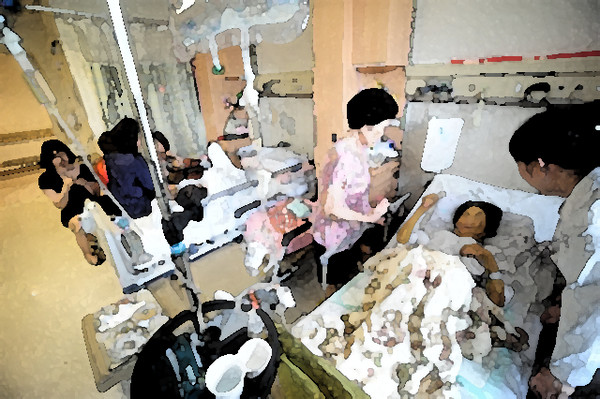
The number of cancer patients in Korea increased again in 2021 as the number of cancer screenings, which had decreased due to Covid-19, increased again and the scope of registration expanded.
It was also found that six out of 10 cancer patients were those who survived for more than five years.
The Ministry of Health and Welfare and the Korea Central Cancer Registry released the 2021 national cancer registry statistics on Thursday, collected through the national cancer registry statistics project. Each year, the registry collects and analyzes data on cancer patients based on medical records from medical institutions to calculate the cancer incidence, relative survival, and prevalence rates of the preceding two years.
According to the registry, the number of new cancer cases totaled 277,523 in 2021, an increase of 27,002 (10.8 percent) from 2020. The ministry explained that this was due to a rebound in cancer screening rates, which had dropped due to the Covid-19 outbreak in 2020, and an expansion of the scope of cancer registration through the revised cancer registration guidelines.
It added that the national cancer screening rate increased from 49.2 percent in 2020 to 55.1 percent in 2021. Besides, the number of cancer patients increased as some benign tumors of colon and stomach cancer that were not previously classified as cancer were registered as cancer, reflecting the revised International Classification of Diseases for Oncology (ICD-O) on Jan. 1, 2021.
Compared to 2020, the number of thyroid patients increased most steeply by marking a 19.1 percent rise to 5,667, followed by 15.8 percent (4,471) for colorectal cancer, 15.3 percent (3,824) for breast cancer, 10.2 percent (1,729) for prostate cancer, 9.4 percent (2,516) for gastric cancer, and 8.2 percent (2,397) for lung cancer. However, liver cancer decreased by 1.1 percent (165).
Thyroid cancer was the most common cancer in 2021, followed by colorectal, lung, stomach, breast, prostate, and liver cancers. Compared to 2020, colorectal and lung cancers changed their rankings.
Among men, lung, stomach, colorectal, prostate, and liver cancers were the most common, while in women, breast, thyroid, colorectal, lung, and stomach cancers were the most common.
Compared to other regions of the world, Korea's cancer rate was 289.3 per 100,000 people, lower than the Organization for Economic Cooperation and Development (OECD) average of 300.9, the U.S. (362.2), Canada (348.0), France (341.9), and Italy (292.6).
The five-year relative survival rate for cancer patients diagnosed between 2017 and 2021 was 72.1 percent, meaning that over seven out of 10 cancer patients survive for five years or more. The five-year survival rate has continued to increase and is 6.6 percentage points higher than the rate from 2006 to 2010 (65.5 percent).
By gender, the survival rate for women (78.2 percent) was higher than for men (66.1 percent) due to the higher incidence of thyroid and breast cancers in women.
By cancer type, thyroid cancer had the highest survival rate at 100.1 percent, followed by prostate cancer (96.0 percent) and breast cancer (93.8 percent). However, liver cancer (39.3 percent), lung cancer (38.5 percent), gallbladder and biliary tract cancers (28.9 percent), and pancreatic cancer (15.9 percent showed relatively low survival rates.
Compared to about a decade ago, cancer types with survival rates that increased by more than 10 percentage points were lung cancer (18.2 percentage points), multiple myeloma (15.1 percentage points), esophageal cancer (12.8 percentage points), and liver cancer (11.0 percentage points).
Some 2,434,098 people who were diagnosed with cancer since 1999 were in treatment or remission as of Jan. 1, 2022, an increase of 157,297 from the previous year (2,276,792). This means that one out of every 21 Koreans (4.7 percent of the total population) is a cancer patient, according to the ministry.
Thyroid cancer also took the largest share, accounting for 21.5 percent of the total, followed by stomach, colon, breast, prostate, and lung cancer. Men were most likely to have stomach, colorectal, prostate, and thyroid cancers, while women were most likely to have thyroid, breast, colorectal, stomach, and cervical cancers.
In particular, the number of cancer patients who survived five years after their cancer diagnosis accounted for more than half of the total cancer prevalence, reaching 1,479,536, an increase of 111,396 from the previous year (1,368,140).
"A significant decrease in survival rate due to delayed cancer diagnosis during Covid-19 has not been confirmed so far, and we will strive to ensure that life-cycle cancer prevention, including early screening, is carried out even in the event of a future pandemic," said Jeong Tong-ryong, the ministry’s public health policy officer.
National Cancer Center Director Seo Hong-gwan said, "Thyroid cancer, which has a five-year relative survival rate of 100.1 percent, has become the number one cancer for three consecutive years, showing that thyroid cancer screening is active.”
Seo added that it is more important for asymptomatic people to be screened for the six cancers covered by the National Cancer Screening Program than to undergo thyroid ultrasound.

